
Kaboom! is an action video game published in 1981 by Activision for the Atari VCS. It was programmed by Larry Kaplan, and David Crane coded the overlaid sprites. The game was well received and sold over one million cartridges by 1983.

Joust is an action game developed by Williams Electronics and released in arcades in 1982. While not the first two-player cooperative video game, Joust's success and polished implementation popularized the concept. Players assume the role of knights armed with lances and mounted on large birds, who must fly around the screen and defeat enemy knights riding buzzards.

Miner 2049er is a platform game developed for the Atari 8-bit family of home computers by Bill Hogue and released by his company, Big Five Software, in 1982. The player controls Bounty Bob through multiple levels of a mine, with the goal of traversing all of the platforms while avoiding or defeating enemy mutants. At a time when "climbing games" such as Donkey Kong had four screens, Miner 2049er had ten.
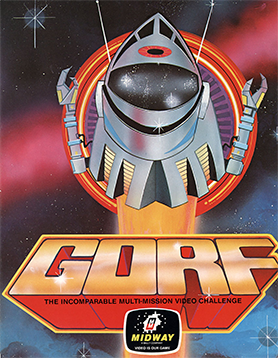
Gorf is an arcade video game released in 1981 by Midway Manufacturing, whose name was advertised as an acronym for "Galactic Orbiting Robot Force". It is a fixed shooter with five distinct levels, the first of which is based on Space Invaders and another on Galaxian. The game makes heavy use of synthesized speech for the Gorfian robot which teases the player, powered by the Votrax speech chip. Gorf allows the player to buy two additional lives per quarter before starting the game, for a maximum of seven lives.
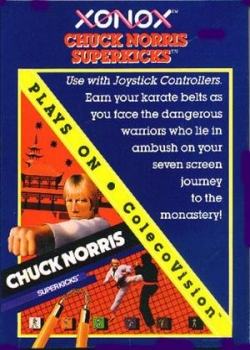
Chuck Norris Superkicks is a video game produced by Xonox in 1984. It was later sold as Kung Fu Superkicks and Super Kung Fu when the license for the use of the name Chuck Norris expired. The game was produced for the Commodore 64, VIC-20, Atari 2600, and ColecoVision as part of Xonox's double-ender cartridge line.
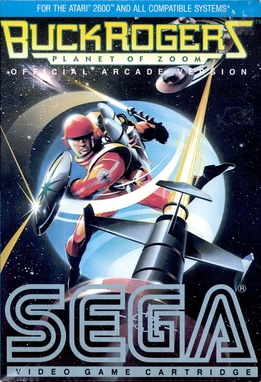
Buck Rogers: Planet of Zoom, known as Zoom 909 in Japan, is a pseudo-3D rail shooter released as an arcade video game by Sega in 1982. The player controls a spaceship in a third-person perspective, adapting the three-dimensional perspective of Sega's earlier racing game Turbo (1981) for the space shoot 'em up genre. It used the Buck Rogers license, referencing the space battles, though Buck himself is never seen.
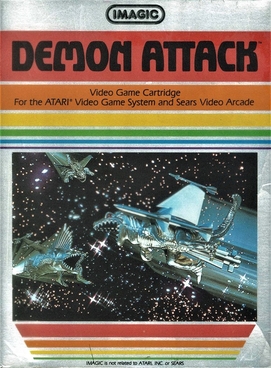
Demon Attack is a fixed shooter programmed by Rob Fulop for the Atari 2600 and published by Imagic in 1982. It sold over 2 million cartridges. Demon Attack was ported to the Intellivision, Magnavox Odyssey 2, Atari 8-bit family, VIC-20, Commodore 64, Tandy 1000, TRS-80, IBM PCjr, and TRS-80 Color Computer. There is also a port for the TI-99/4A titled Super Demon Attack.
Robert S. Harris, nicknamed RoSHa, is the designer and programmer of several 1980s home computer and console games, including War Room and Killer Bees!.

Killer Bees! is an action video game written by Robert S. Harris for the Magnavox Odyssey2 and published in 1983.

One on One: Dr. J vs. Larry Bird, commonly known as One on One, is a basketball video game written by Eric Hammond for the Apple II and published by Electronic Arts in 1983. It was initially ported to the Atari 8-bit family, ColecoVision, Commodore 64, and IBM PC. Versions followed for the TRS-80 Color Computer, Macintosh, Amiga, and ZX Spectrum. In Europe, the publisher was Ariolasoft. Atari Corporation released an Atari 7800 port in 1987.

M*A*S*H is an action game, based on the film, written for the Atari 2600 and published by Fox Video Games in 1983. It was designed and programmed by Doug Neubauer. Ports to the Atari 8-bit family, VIC-20, TI-99/4A, Intellivision, and ColecoVision followed.

Blue Max is a scrolling shooter written by Bob Polin for the Atari 8-bit family and published by Synapse Software in 1983. It was released for the Commodore 64 the same year. U.S. Gold published the Commodore 64 version in the UK in 1984 and ported the game to the ZX Spectrum. In 1987, Atari Corporation published Blue Max as a cartridge styled for the then-new Atari XEGS. The player controls a Sopwith Camel biplane during World War I, attempting to shoot down enemy planes and bomb targets on diagonally scrolling terrain. The game is named after the medal Pour le Mérite, informally known as Blue Max. Its theme song is "Rule, Britannia!".
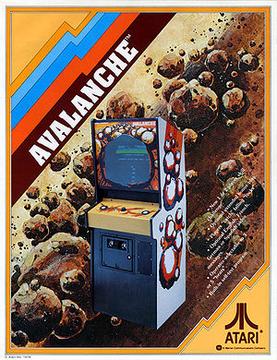
Avalanche is an arcade video game designed by Dennis Koble and released by Atari, Inc. in 1978. The object is to catch falling rocks with a controllable set of paddles that diminish in number and size as the rocks fall faster and faster. The concept gained a much wider audience after Activision released an unauthorized adaptation in 1981 as Kaboom! for the Atari 2600. The only official home port of Avalanche is for the Atari 8-bit family.

Cosmic Ark is an Atari 2600 game designed by Rob Fulop and published by Imagic in 1982. The objective is to gather specimens from different planets in a spaceship which contains the survivors from the city of Atlantis. There are two versions of the cartridge. One allows the player to toggle the starfield display with the Black & White / Color TV switch. In the other the starfield cannot be disabled.

Spider-Man is a vertical scrolling action game written by Laura Nikolich for the Atari 2600, and released in 1982 by Parker Brothers. It was both the first video game to feature Spider-Man and the first Marvel Comics based video game.
There have been a variety of Sesame Street video games released for video game platforms. Most of the Sesame Street video games were published and developed by NewKidCo.

Capture the Flag is a 3D first-person perspective, two player, video game, released for the Atari 8-bit family and VIC-20 by Sirius Software in 1983. It was written by Paul Allen Edelstein as the follow-up to his 1982 game, Wayout, which has similar maze-based gameplay for one player. Along with its predecessor, Capture the Flag was among the first 3D maze games to offer the player full 360 degree movement, and one of the earliest multiplayer games from a first-person perspective within a 3D rendered environment.
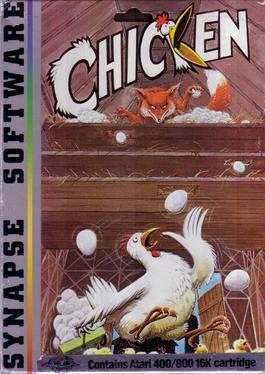
Chicken is a video game for the Atari 8-bit family written by Mike Potter and published by Synapse Software in 1982. The game is similar to Atari, Inc.'s. 1978 arcade video game Avalanche, replacing the buckets and boulders with a hen trying to catch her eggs.
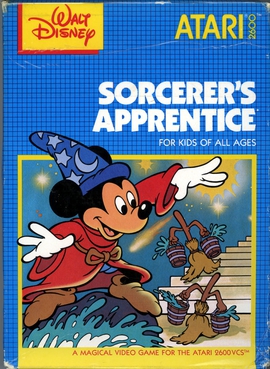
Sorcerer's Apprentice is a video game for the Atari 2600, based on a sequence from the film Fantasia.

Bandits is a 1982 fixed shooter written by Tony and Benny Ngo for the Apple II and published by Sirius Software. The game is a clone of Taito's 1980 Stratovox arcade video game where the goal is to prevent aliens from stealing objects. Bandits was ported to the Atari 8-bit family, Commodore 64, and VIC-20.


















